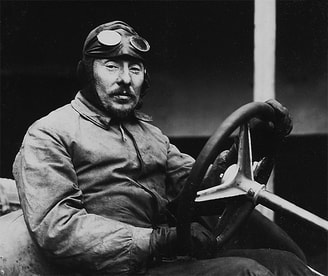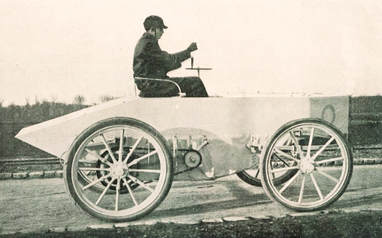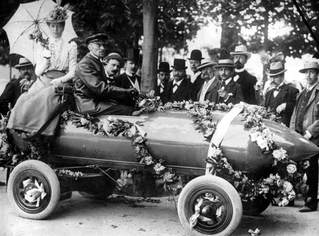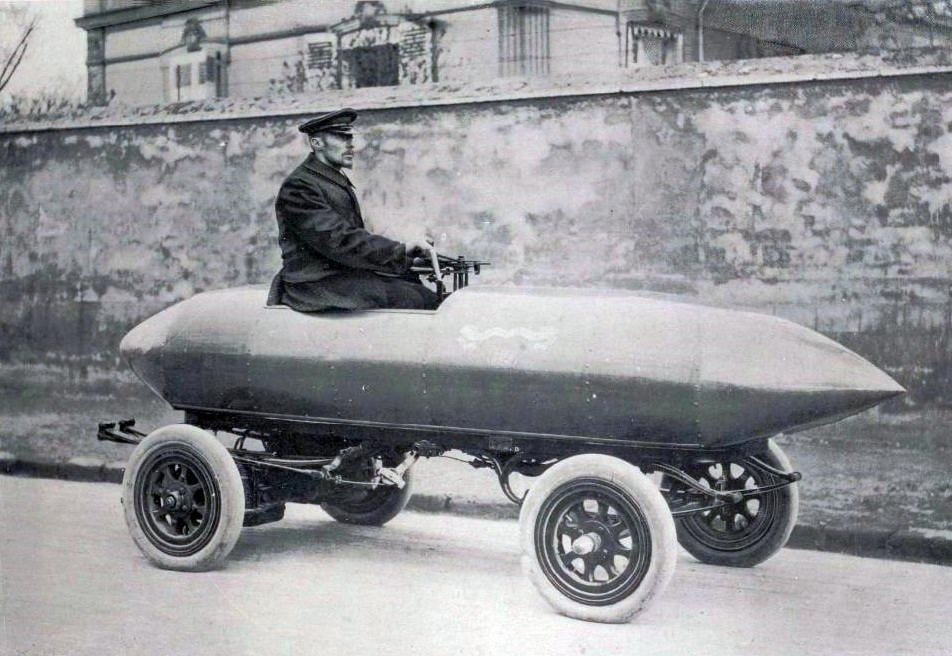 Camille Jenatzy
Camille Jenatzy
On April 29 of the year 1899, the "La Jamais Contente", driven by the Belgian race car driver, Camille Jenatzy, set a new land speed record of 65.79 miles per hour at Achères, Yvelines near Paris, France. What makes the event so memorable is that it is the first time that an automobile breaks the 100 km per hour barrier, as well as the "mile a minute" barrier. Also, it is the first time that a car is specially built just to break the land speed record. What makes the event so interesting is that the La Jamais Contente was electric!
Camille Jenatzy was born in Schaerbeek, a suburb of Brussels, Belgium, in 1868 to Constantin and Honorine Jenatzy. Constantin was the owner of a successful rubber products manufacturing firm that specialized in producing tires. After graduating as an electrical engineer, Camille followed in his father's entreprenurial footsteps and formed the Compagnie Générale des Transports Automobiles in Paris to manufacture electric taxicabs. Later, Camille would become a well-known race car driver, nicknamed the Le Diable Rouge ("The Red Devil") after the colour of his beard and his Mephistopheles-type looks.
To publicize his company's vehicles, Camille Jenatzy began to participate in automotive spectacles, the most famous of which were a series of speed record duals between himself and Count Gaston de Chasseloup-Laubat that began in January of 1899. Chasseloup-Laubat, dubbed by the press as the "Electric Count", had set the first ever land speed record of 39.24 miles per hour on December 18, 1898, driving the Jeantaud Duc, an electric car manufactured by Charles Jeantaud. The Electric Count's new record prompted Jenatzy to challenge the Electric Count to a race on a flat, deserted road in Achères on January 17, 1899. Jenatzy went first and broke the Electric Count's record, achieving a speed of 41.4 mph. When it was the Electric Count's turn, he bested Jenatzy's new record with a speed of 43.93 mph and another land speed record.
 Jeantaud Duc Profilée
Jeantaud Duc Profilée
Not to be outdone, Jenatzy challenged the Electric Count to a rematch, which took place a mere 10 days later on January 27, 1899. Jenatzy won the rematch and set a new land speed record of 49.9 mph. Jenatzy's victory, however, was lopsided because the Electric Count burned out the motor on the Jeantaud Duc and was unable to finish his run. This mishap did not deter the Electric Count. He had the Jeantaud Duc rebuilt and furnished with a radically different body, one that most likely constitutes the first attempt at automotive streamlining. The front and rear of the body of the rebuilt car were tapered to cut down on wind resistance. Paying homage to the innovative body countouring, the refurbished car was now called the Jeantaud Duc Profilée. At the wheel (really tiller) of the Jeantaud Duc Profilée, the Electric Count retook the land speed record from Jenatzy on March 4, 1899, achieving a speed of 57.6 mph.
Realizing he needed to do something more drastic to regain the title from the Electric Count, Jenatzy set about building a new car from the ground up. The result was the "La Jamais Contente", which translates to "The Never Satisfied". With his new car, Jenatzy took streamlining one step further. The body of the La Jamais Contente was shaped like a cigar, with an elongated, pointed front end and a shorter, pointed posterior end. This streamlined shape was achieved using a newly developed aluminum alloy known as partinium, which was lightweight and malleable. Interestingly, the body did not substantially enclose the chassis or the driver, who sat upright and was buffetted by air flowing over the body, which had to significantly detract from any benefits provided by the aerodynamic shape of the body.
The La Jamais Contente was driven by two 25-kilowatt electric motors, directly connected to the rear wheels, respectively. Power to the electric motors was provided from two 80 cell Fulmen lead acid batteries, which comprised about half the entire weight of the car. The motors ran at 200 V, drew 124 Amperes and generated about 68 horsepower.
Realizing he needed to do something more drastic to regain the title from the Electric Count, Jenatzy set about building a new car from the ground up. The result was the "La Jamais Contente", which translates to "The Never Satisfied". With his new car, Jenatzy took streamlining one step further. The body of the La Jamais Contente was shaped like a cigar, with an elongated, pointed front end and a shorter, pointed posterior end. This streamlined shape was achieved using a newly developed aluminum alloy known as partinium, which was lightweight and malleable. Interestingly, the body did not substantially enclose the chassis or the driver, who sat upright and was buffetted by air flowing over the body, which had to significantly detract from any benefits provided by the aerodynamic shape of the body.
The La Jamais Contente was driven by two 25-kilowatt electric motors, directly connected to the rear wheels, respectively. Power to the electric motors was provided from two 80 cell Fulmen lead acid batteries, which comprised about half the entire weight of the car. The motors ran at 200 V, drew 124 Amperes and generated about 68 horsepower.
 Jenatzy & his wife with
the La Jamais Contente
Jenatzy & his wife with
the La Jamais Contente
On April 22, 1899, Jenatzy returned to the flat, deserted road in Achères to regain his title. A gentle rain fell most of the day, until just after 3:00 PM when it stopped. At that time, the La Jamais Contente was brought to the starting line and with a simple "Go" and a lowering of an arm, Jenatzy flipped a switch and the car bounded forward. After about 10 yards, the La Jamais Contente lept forward again and disappeared in a cloud of dust. Driving incredibly straight, Jenatzy piloted the La Jamais Contente for 2 km down the road and into the record books. He was the first man to travel faster than 100 km in an automobile. Jenatzy's record would hold for more than two years before it was broken by Léon Serpollet, driving a car called the "Easter Egg", which was not electric......it was driven by steam!


